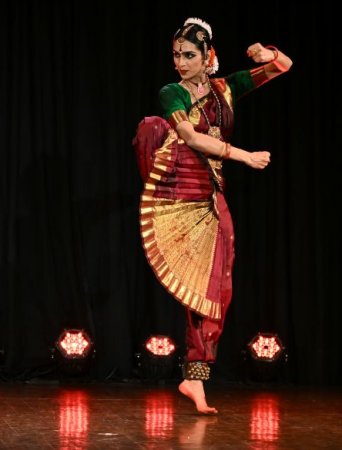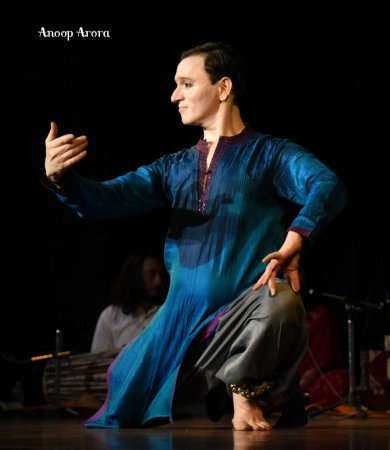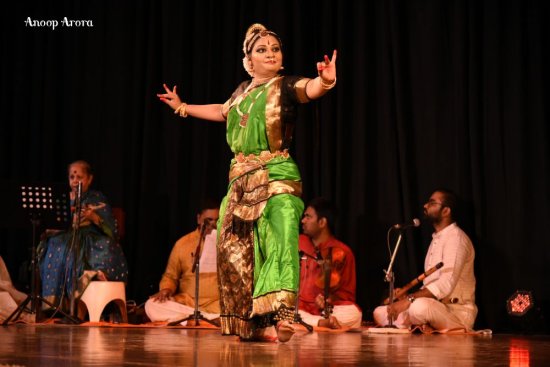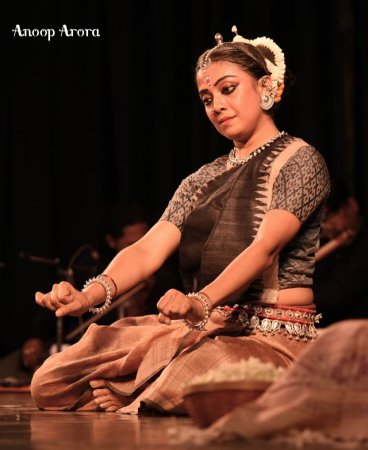
|   |

|   |
Display of mastery at Natya Vriksha's World Dance Day 2025 Young Dancers' Festival- Shveta Arorae-mail: arorashveta1806@gmail.com Photos: Anoop Arora July 5, 2025 The celebration is that of the World Dance Day, and the temple to go and worship it is the Natya Vriksha World Dance Day utsav at IIC Delhi. The mornings of this annual event in April feature workshops and the afternoons have seminars, while the evenings are kept for the Young Dancers Festival, where the best of the young and established dancers from all forms are invited and given a platform to showcase their talent.  Madhura Bhrushundi (Photo: Sarabjit Singh Dhillon) This year, the first dancer on day one, 26 April, was Madhura Bhrushundi. The entire auditorium was filled with the scent of mogra flowers, which were placed in boat-shaped metal vessels and also spread on the stage. A statue of Nataraja stood on the stage. Madhura began with a pushpanjali in ragam Shivshakti, paying an ode to Shiva and Shakti through the poetic work of Thirumular. She wore a maroon sari with a green blouse and her red neckpiece stood out. Her accompanists were her guru Geeta Chandran on nattuvangam, K. Venkatesh on vocals, her husband Manohar Balatchandirane on mridangam, K.P. Nandini from Chennai on the violin and Varun Rajasekharan on ghatam. With crisp footwork and hastas, she covered the stage to offer pushpanjali. I have always wished that Natya Vriksha feature one of their own talents for WDD, since there is no dearth of them, and the audience would also get a taste of the stars that are being nurtured there. Shiva and Shakti were depicted by jata and veni, the two hands facing, clasped palm to palm and then reversed to show the oneness in them; the two steeds, Nandi and the lion, damru and agni in Shiva's hands and the mother Parvati in varad hasta, together residing on the mountain Kailash. Madhura's central piece was a Khamas varnam in adi talam, a composition by Ponnaiah Pillai. It is always a pleasure to hear the violin playing the notes of the raga prior to the performance. The nayika here calls upon her sakhi to go and get Lord Brihadishwara as soon as possible as she pines for him. Lord Manmatha strikes her with his arrows. Madhura depicted how he is surrounded by snakes as he walks with elan, but they scare her. He rides on his steed. There is no one else like him. Though he has the third eye and wears the tiger skin, all others look ordinary in front of him. She shakes a tree and collects flowers, strings them into a garland to take to him and when she opens the doors for his darshan, she is stunned. Her heart yearns to embrace and kiss him and Manmatha strikes her with his arrows. She dreams of him coming from behind her and embracing her. She is intoxicated by her emotions. Since it is time for their union, the singing of the birds and the humming of the bees leave her in greater distress, like a fish without water. She offers the sakhi her jewels and asks her to be her messenger. Madhura captured the essence of the emotions and cravings that the nayika is experiencing. This was complemented by the vocals by K. Venkatesh. The nritta portions were outstanding. Her guru Geeta's rendition of the jatis and nattuvangam were powerful, stressing the syllables, and Madhura was perfectly in tandem. Her footwork was deft and she used squats, turning back in squats, leg lifts front, sideways and backwards, and balancing in stances and postures for Shiva. She moved side to side, forward, backward and in circles, covering the entire stage, incorporating jumps and leaps into the jati. It really was a captivating performance. Madhura's final piece was Sharada Bhujangam, an ode to Maa Sharada by Adi Shankaracharya. The Acharya says that the bosom of Maa Sharada is filled with the pitcher of nectar, with abundant blessings and grace, blessing all bhaktas. Madhura took a one-legged stance, half-squatting with the veena and showing the gyaan hasta. Her face is more beautiful than the moon and her lips are as red as the bimbaphal. Her glance is laden with daya (compassion) and her hand held in gyaan mudra, spreading knowledge. She showers her followers with the arts. She is adorned by her ornaments and resides in the town of Sringeri by the river Tunga. Her hair is braided into a beautiful veni, and her voice is like that of the parrot that sits on her shoulder. The mother rides on various steeds as she takes on different forms - deer, horse, lion, eagle, swan, elephant, large bull. Madhura depicted the various steeds. Her glow enchants the world. She is like the lotus. She is worshipped through sangeet and nritya. Madhura depicted the playing of various instruments. Lastly, she sat with her legs crossed in a yogic stance and her hand in kripa hasta. It was a complete piece with rhythm, music, vocals and choreography, all completely captivating. Madhura shone like a red flower on the Natya Vriksha stage.  Dheerendra Tiwari The next performer for the evening was well-known Kathak soloist Dheerendra Tiwari. He is a disciple of Pt. Rajendra Gangani and has been under the guidance of Aditi Mangaldas as part of the Drishtikon Dance Company. He was accompanied by Yogesh Gangani on the tabla, Ashish Gangani on pakhawaj, Samiullah Khan on vocals and Ayub Khan on sarangi, with padhant by Diksha Tripathi. Dheerendra was dressed in a blue kurta and a grey lower. The kurta had a purple border on the neck and the cuffs, designed by Sandhya Raman. He said he had never felt so comfortable in an outfit. He began his recital with 'Aditya Stotram'. In the night, the lotuses shut, the birds return to their nests and the deer huddle together. But as the day dawns, the sun god harnesses his horses and begins to ride them, the light blazes and falls on earth, the lotuses begin to bloom, the birds chirp and ready themselves for flight, and the deer gallop and run. This was depicted through nritya. 'Adidev namastubhyam . . . twam sooryam pranamyam': the nritta was in chautaal, 12 beats. Dheerendra presented footwork in an upaj, thaat with twisting feat, the tukde and uthaan he presented had the paran ang. He did a tukda, a composition of Swati Sinha, a paran and chakkars in high speed on one foot, calling them the 'lattu chakkar', plavan bhramari, various paran, tukde, layakari and footwork. To some tukdas, he added the flavour of Rajasthan - he took chakkars at a slant, his hands rotating in Rajasthani nritta. His ginti ki tihai was very precise nritta. The final piece of his performance was 'Ahilya Uddhar'. The bhajan that he chose was 'Param kripa swaroop hai Shri Ram'. He mentioned the influence of Guru Shama Bhate in developing the concept of this piece. Ahilya starts her day with pooja and aarti of Rama. Dheerendra took stances for Rama with his bow and noble demeanour. Rishi Gautam comes back from his tapasya, she cooks and serves him, and by the time she finishes her chores, he is fast asleep. She does not like his groping in the night. The next morning, he gets ready and goes away again. Ahilya is a pativrata sati. She serves her husband unquestionably. She was narrated as saying that she would offer herself to him when he comes. But somewhere in her heart, she longs to be loved. Indra sees his chance and disguises himself as the rishi. He makes love to her, but just then, in walks the rishi. He curses her to become a rock, and there she lies in wait for her deliverer, Rama. He arrives, sets his foot on the rock and delivers her from the curse to attain moksha. Dheerendra depicted the tale, each frame and emotion so well, making each emotion his own in gat bhava.  Abhinaya Nagajothy The second day's lineup had another couple of star performers. Abhinaya Nagajothy is the daughter and disciple of Guru Seetha Nagajothy and Guru P. Nagajothy. She was accompanied by Seetha Nagajothy on nattuvangam, K. Venkatesh on vocals, Manohar Balatchandirane on mridangam, P. Raghavendra Prasath on violin, Siddharth Dalbehera on flute, assisted by Sritanaya Sharma. Sritanaya introduced the first piece as 'Vaniki Vandana', a piece written and composed by her gurus Seetha and P. Nagajothy, an invocation of Saraswati, the goddess of arts and music. She holds a quill in one hand and a book in the other. She plays her divine veena. The piece was set in Ragamalika, adi talam. It is always a divine experience to hear Raghavendra's violin before each piece. Abhinaya wore a black and green aharyam. Through stances and gestures, Goddess Saraswati was shown to be karuna nidhim; she sits holding her veena. Her hair is braided and she rides her swan. The nritta had graceful footwork, the hastas were sharp, she covered the stage as she went around depicting the musical instruments being played, and her jatis had leaps and leg lifts. The second piece she performed was a shabdam, which is used in Kuchipudi as a framework for a story. Here she presented the 'Mandukya Shabdam', where the croaking of the toads is taken to be the chanting of the Vedas by the rishis. In this shabdam, it is shown how the gaja and the graha were incarnations - in its previous birth, the gaja was King Indradyumna, who was cursed by Rishi Agastya in the beautiful forest - and how Lord Vishnu comes to liberate them and grant moksha. The piece used both technique and abhinaya. The shabdam ended with an invocation to Lord Rama. It was in Ragamalika, mishra chapu talam. The forest was shown to be abounding in flowers, creepers and trees, with wild animals - deer prancing, birds flying and peacocks dancing - and the munis retelling the tale. In these environs, the gaja, who was playing in water, is caught by the crocodile in a life-threatening grip. Lord Vishnu, who is in Vaikunth with Goddess Lakshmi, comes immediately to help, vanquishing the graha with his chakra. After enacting the piece, Abhinaya paid obeisance to Lord Vishnu and Rama with 'Jai Raghuram'. The piece also featured some agile nritta. The next piece she presented was from the classic Kuchipudi repertoire, a piece in which Krishna's queen Satyabhama talks to her friend Madhavi about herself and tells her to go and get Krishna to her. The friend teases her and asks her to name her husband, but she does not do so and refers only coyly and obliquely to her husband. This is done through vachika abhinaya as the nattuvanar and the dancer talk to each other. Satyabhama says, he is the one who bears the conch, he plays on the flute and wears the makarakriti kundal, but she refuses to utter his name. Madhavi asks her to write a letter to him to appease him and Satyabhama senses auspiciousness in this effort. The choreography was by Guru Seetha Nagajothy. Abhinaya attempted the expressions of a shy Satyabhama, who covers her face with her hands and holds her braid, lips trembling. She imagines Krishna romancing her and is pained by the environs, which are ripe for love - flowers, bees, the breeze, the moon, all pain her, and so she sits down to write her letter. Abhinaya's nritta and nritya were well-executed and her one foot rested on one toe while coming to the fore was feminine. The final piece was a Shiv tarangam on the brass plate. The piece was an ode to Lord Shiva, the Nataraja. The Ganga settles on the knot of his locks and flows in a trickle. On the left is Maa Gauri, damru and agni in his hands; he rides the Nandi, smeared with bhasma, the chandra as his head ornament. Abhinaya started the tarangam standing cross-legged on the plate. She dragged the plate forward and backward effortlessly, taking half chakkars with ease. She got off the plate and ended with a leg lift, holding the big digit with her hand. The performance was over one hour long, which speaks to the stamina of the dancer.  Saswati Gorai Ghosh The last performer for the festival was Saswati Gorai Ghosh, a disciple of Guru Sharmila Biswas, performing Odissi. Saswati was accompanied by Srinibas Satpathy on flute, Agnimitra Behera on violin, Rajesh Kumar Lenka on vocals and Buddhanath Swain on pakhawaj. She wore a black and off-white sari for aharyam. The first piece she performed was 'Jay Jay Dev Hara' from Geeta Govind by Jayadeva. It was an invocation of Lord Hari - Vishnu or Krishna. The manjiras played, the vocalist sang and the flute created the sounds of a conch. The bhakta comes looking for the lord, sees the flags atop the temple and bows. The nritya depicted Krishna as he who vanquished Kaaliya Naag and put his foot on the snake's hood. The resounding call of 'Jaya Dev Hare' gave everyone goosebumps. Krishna wears his peacock feather and kundal and carries his flute. Saswati displayed her mastery over the footwork and performed leaps in broad plie and chakkars on her knees. She depicted Vishnu on his steed, Garuda, with the flying action, her movements precise and expansive, covering the stage. Saswati stood out for her very lissom moves. Her chauka and tribhanga were expansive and graceful. Her demeanour was very attractive and the way she created a small corner for her knick-knacks on stage was innovative - she had a vessel with water, her script, a brass urn and some fragrant flowers. The second piece was again a showcase of her inventiveness. It was titled 'Swara Vilas'. Saswati said that she believed there is a visual aspect in the fabric of the melody of each raga. In Charukeshi, there is a gentle, gradual unfolding of a form in a very delicate rhythm. A woman who envisions her lover in the notes of the raga and surrenders to him, totally engrossed in him, is the melody of the raga. Depicting a beloved in the notes of the raag, Saswati lent herself very sensitively to this abstract piece. Lying supine, she showed a woman asleep as she awakens to the notes of the music. She gradually gets up and moves slowly, gracefully, braiding her hair. The mardala was also not playing in these moments, just the flute. Waves run through her body. After a few to and fro soft moves, gently leaping, she moved with her hand on her chin and finally, surrendered to the embrace of her beloved. This was a very aesthetically rendered piece that stayed with you. It started with soft notes and ended the same way, a magic woven with the vocalist dwelling on the bols and the sound of the footwork and her ghunghroos. The next piece was based on the Ramayana, but it was about how a mother edits, colours and improvises a story to put her son to sleep. Maa Yashoda is telling the tale of Rama to little Krishna when he refuses to sleep. I had seen Guru Geeta Chandran, who was sitting there that evening as the organizer, perform the piece many years back and it has still stayed with me. This, she said, was Yashoda's Ramayana. Saswati started with Maa Yashoda wearing her sari. She beckons to Krishna to come and kiss her. She lifts him, throws him up, plays with him, she rocks him on her back, walks him holding his finger. As she puts him down on the palna, she is almost asleep herself. But Krishna wants to hear a story and Maa Yashoda begins to tell the story of Rama. She tells him about the four brothers learning to fight, and she playfully teases him that while he has butter, Rama learnt to fight, which Krishna cries at. The story progresses as little Krishna refuses to sleep and comes to the point when the golden deer appears and Rama follows him. Lakshmana too leaves and the demon comes in disguise to abduct Sita. It is at this point that little Krishna removes the thumb that he was sucking and asks for his bow and arrow to shoot Ravana. The innocent mother is scared. She goes to the mystic to get his jhara, gets him back and bolts all doors and windows to ward off evil spirits. She cries and then blows out the lamp and sleeps with Krishna. Saswati wove the story in an expansive and well-defined manner. It was a befitting final performance.  Shveta Arora is a dance-mad writer who chronicles classical dance events in Delhi (and also those online). In 2009, she started the blog Kala Upasana at delhiculturecomment.blogspot.com, where she began posting her own writing along with photographs clicked by Anoop Arora, her husband. She's been dancing all her life as a devotee, but resumed her formal training in Kathak in her 50s and has passed her fifth year Kathak exams. |